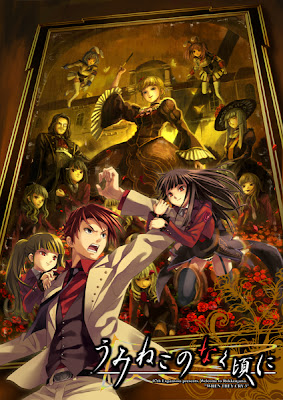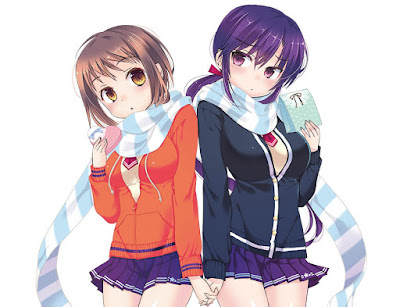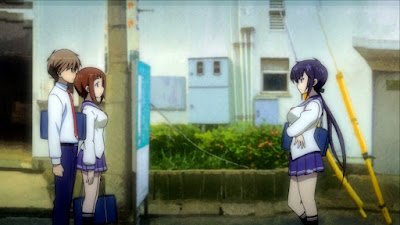Umineko no Naku Koro Ni: Sound Novel Review
Title: Umineko no Naku Koro Ni
English Title: When the Seagulls Cry
Game Type: Doujinshi Sound Novel
Format: DVD
Developer: 07th Expansion
Writer: Ryukishi07
Story Arcs: Episode 1: Legend of the Golden Witch, Episode 2: Turn of the Golden Witch, Episode 3: Banquet of the Golden Witch, and Episode 4: Alliance of the Golden Witch
There are many ways to show your love towards the hobby of anime, manga, and videogames. In Japan, the doujinshi scene of self-published amateur works makes up a large percentage of the otaku market. Few people in the doujinshi world that have become as successful as the group known as 07th Expansion, breaking onto the scene with the incredibly popular Higurashi no Naku Koro Ni (English title: When they Cry). Umineko no Naku Koro Ni, their follow up series has made waves in the community, getting a popular manga, and a 26-episode anime. My first exposure to the series was the popular anime when it was released in 2009. I had the pleasure of playing through the first four story arcs thanks to a compilation DVD that was released in Japan. It is a doujinshi game, so it has some flaws, but it has many redeeming features that make it one of the best experiences out there.
The basic storyline of Umineko is a seemingly simple storyline from an outside perspective; a wealthy family of Japanese aristocrats goes to their annual family meeting in an isolated island named Rokkenjima in 1986. There is no avenue for escape because a typhoon hits the island during the family meeting. As they go through the family meeting, several family members are murdered according to the Golden Which’s epitaph. The living family members band together and desperately fight for survival while trying to solve the epitaph to end the murders. That is one portion of the storyline for the first four episodes of the story arc. The second portion is the parallel battle between Battler Ushiromiya and Beatrice, the golden witch. Battler’s goal is to prove that the murderers of his family is human, while Beatrice shows Battler that the family murders could only be done thorough witches and magic. The game ends if Battler surrenders and accepts witches and magic. The first portion is the horror element happens in all four story arcs, Battler and Beatrice dukes it out in the parallel word from episode 2 onwards in the mystery element.
What makes the game unique is the each episode is a different story arc. Episode 1: Legend of the Golden Witch introduces the player to the rather large cast, and their complex relationship amongst each other. Beatrice’s existence is implied, and her presence leads to the murder of the Ushiromiya family. Episode 2: Turn of the Golden Witch follows the events of the first story, and it features the first battle of wits between Battler and Beatrice in a parallel world. This episode continues with the family meeting and has the family members murdered in a different manner, while including some magical elements. Episode 3: Banquet of the Golden Witch has a different character taking on the mantle of “Beatrice” who subsequently starts killing off the Ushiromiya family and introduces even more fantastical magical elements. It expands the cast with the introduction of the demon servants and several new witches. Episode 4: Alliance of the Golden Witch centers on none other than Battler’s little sister, Ange, who did not attend the meeting in 1986 due to an illness. She is taken care of by the sole survivor of the Rokkenjima incident who treats her with disdain, isolated and saddened by her lonely world, Ange Ushiromiya tries to explore the world of 1998 to determine what killed her family. The storyline shifts between the incident in 1986 and Ange’s time in 1998. The expansive narrative and its unique shifting focus makes for a great experience.
The storyline for Umineko no Naku Koro Ni is quite complicated compared to most games out there. The main theme of the storyline is to determine whether humans did the mysterious murders or whether a supernatural force did them. From episode 2, Battler is locked in a game of logic to explain the murders of his family. He must explain how a person can logically do each act of murder of his family members or else he loses the game. The game uses the traditional motif of the locked room mystery that is prevalent in stories of games and anime such as Ace Attorney and Case Closed. The logical arguments are fairly well known in the world of philosophy, including the Devil’s Proof and Schrodinger’s Cat. Umineko also utilizes a variety of gaming, political, and anime references to give a nod to the most ardent fans. The way it combines a wonderfully crafted storyline with thoughtful arguments in logic is nothing short of brilliant. The game is probably one of the most intelligent games out there and requires the reader to think logically about the situation to see if they can make the same determination. The player must have intelligence to understand some of the esoteric and obscure references in the context of the greater storyline.
A game can have a wonderful storyline, but it needs an equally compelling cast of characters to keep them interested. There are eighteen characters in the Ushiromiya clan or work for them in the island that are trapped in the Rokkenjima incident in 1986. They are all compelling in their motivations and their personal dynamic. The head of the family is Kinzo Ushriomiya, the aging charismatic leader of the family. He is on his deathbed and the family is meeting to determine how they will spread his wealth. His four children Krauss, Eva, Rudolf, and Rosa are all wealthy members of the upper class, each with different financial situations, family problems, and sibling dynamics. During the family meetings they squabble, fight, and try to position themselves for power. Their children, the cousins, are all very close with each other. Jessica is the energetic tomboy, George is the older brother of the cousins, Battler is the hotheaded main protagonist and he is exceptionally intelligent, Ange is his little sister that was too sick to attend the family event, and Maria is the creepy younger cousin with a fascination with the occult. On the other side are the witches, demons, and various other supernatural being that inhabit the parallel world where Beatrice is challenging Battler’s logic of the murders. Beatrice is the Golden Witch, who supposedly gave Kinzo his gold to turn the Ushiromiya family into one of the most powerful families in Japan. She serves as the main antagonist over the course of the first four episodes. Several other witches eventually pop up that twist the story in unique and interesting ways. The cast for the series is expansive, and their relationships are very complex. Some of the biggest plot twists in the series comes from revelations about these relationships.
Umineko is a sound novel; this means that it is a novel with static picture frames and a soundtrack. Each episode of the story arc has around 8-15 hours of playtime. There is the main storyline that tells the main exposition. As you play through the game, you get tips that may or may not be relevant over the course of the storyline. Then once each chapter is beaten, the player sees an epilogue called the Tea Party and a secondary epilogue after that to expand the storyline. The game has no interaction except reading the dialog. The backgrounds are simple, yet highly effective. The gruesome murders of the family members are described in such graphic detail that it can give you nightmares for weeks. It also has a horrifying background during those moments that highlights the horrible situation. There is one downside, and that is the text speed. It moves very slowly, and there is no way to adjust the speed of the text. For a game that is text heavy, it is a feature that should have been added to the game experience.
One of the most brilliant points of the game is the soundtrack, which is quite possibly one of the best gaming soundtracks ever put in a game. The music director for the Umineko games is Dai, the lead composer for most of the answer arcs of the Higurashi saga. He leads an expansive team of musical artists that include both professional and doujinshi composers. The music is an important highlight of the Umineko saga, bringing the atmosphere of the game to life. There is a joyous atmosphere presented as the family meets up after so long with an upbeat, happy tone. The soundtrack is lonely and somber as the game shifts on the lonely world of Ange in 1998; it is a solo piano that is punctuated by solo xylophone notes. The musical score is equal parts, haunting, powerful, and joyful. It is a unique mix of music and it does also those genres exceptionally well.
This game is a doujinshi game, so the production values are not exceptional. The character designs have a unique feeling to it that is very polarizing, some may hate it and some may like it. It was initially off-putting at first, but I gradually learned to love the characters designs for the sound novel. Say what you will about the designs, but the clothing for the cast of characters are top class. The Ushiromiya family looked like they walked out of a fashion magazine; they look very sharp and fashionable. Each of the witches has a unique design, from Beatrice’s elegant Victorian-era dress to Lambladelta’s decidedly unique twist on Halloween style. Each of the outfits is iconic in their own way, from the Ushiromiya family to the seven Stakes of Purgatory. Each outfit is accentuated by the single seagull wing design that is used by the family. It is quite an awesome design, and how it is incorporated in all the outfits is brilliant.
Overall, Umineko no Naku Koro Ni one the best experiences you can read on the computer. It is a very intelligent and beautifully written story that is near the top of the video game world. It is hard to believe that a professional game developer does not write such a great story. There are several negatives, the character designs has a unique polarizing character to it, the text moves very slowly, and the production values are below most standard visual novels. What negatives there the game has are outshined by the positives, it is wrapped up with a fast paced, intelligent storyline, a top class soundtrack that puts most games to shame, and a wonderful character dynamic that sucks in the reader. Umineko really does deserve all accolades and honors that are bestowed upon it, it is a really amazing experience.
Kris Zoleta, B.A., M.B.A., started working in Anime Expo as a staffer in Manga Library. He worked in Staff Service in Anime Expo 2006 and became the manager of Manga Lounge from Anime Expo 2007-2010. He was serving on the Board of Directors for the Society for the Promotion of Japanese Animation as Treasurer and Interim CFO for the 501(c)(6) non-profit behind Anime Expo, and he was Co-Chair of Anime Expo 2012. He works in the con world and is one of the most recognized cosplay photographers in the West Coast.
Links
Witch Hunt Translation Project
Ryukishi 07
Umineko Japanese Page
Umineko Rondo PS3 Website
Umineko Chiru PS3 Website
Digital Download Website
NIS America - Umineko Anime USA release
English Title: When the Seagulls Cry
Game Type: Doujinshi Sound Novel
Format: DVD
Developer: 07th Expansion
Writer: Ryukishi07
Story Arcs: Episode 1: Legend of the Golden Witch, Episode 2: Turn of the Golden Witch, Episode 3: Banquet of the Golden Witch, and Episode 4: Alliance of the Golden Witch
 |
| The DVD cover of the first four episodes |
 |
| Beatrice and Lambladelta |
What makes the game unique is the each episode is a different story arc. Episode 1: Legend of the Golden Witch introduces the player to the rather large cast, and their complex relationship amongst each other. Beatrice’s existence is implied, and her presence leads to the murder of the Ushiromiya family. Episode 2: Turn of the Golden Witch follows the events of the first story, and it features the first battle of wits between Battler and Beatrice in a parallel world. This episode continues with the family meeting and has the family members murdered in a different manner, while including some magical elements. Episode 3: Banquet of the Golden Witch has a different character taking on the mantle of “Beatrice” who subsequently starts killing off the Ushiromiya family and introduces even more fantastical magical elements. It expands the cast with the introduction of the demon servants and several new witches. Episode 4: Alliance of the Golden Witch centers on none other than Battler’s little sister, Ange, who did not attend the meeting in 1986 due to an illness. She is taken care of by the sole survivor of the Rokkenjima incident who treats her with disdain, isolated and saddened by her lonely world, Ange Ushiromiya tries to explore the world of 1998 to determine what killed her family. The storyline shifts between the incident in 1986 and Ange’s time in 1998. The expansive narrative and its unique shifting focus makes for a great experience.
 |
| Eva Beatrice, looking intimidating |
A game can have a wonderful storyline, but it needs an equally compelling cast of characters to keep them interested. There are eighteen characters in the Ushiromiya clan or work for them in the island that are trapped in the Rokkenjima incident in 1986. They are all compelling in their motivations and their personal dynamic. The head of the family is Kinzo Ushriomiya, the aging charismatic leader of the family. He is on his deathbed and the family is meeting to determine how they will spread his wealth. His four children Krauss, Eva, Rudolf, and Rosa are all wealthy members of the upper class, each with different financial situations, family problems, and sibling dynamics. During the family meetings they squabble, fight, and try to position themselves for power. Their children, the cousins, are all very close with each other. Jessica is the energetic tomboy, George is the older brother of the cousins, Battler is the hotheaded main protagonist and he is exceptionally intelligent, Ange is his little sister that was too sick to attend the family event, and Maria is the creepy younger cousin with a fascination with the occult. On the other side are the witches, demons, and various other supernatural being that inhabit the parallel world where Beatrice is challenging Battler’s logic of the murders. Beatrice is the Golden Witch, who supposedly gave Kinzo his gold to turn the Ushiromiya family into one of the most powerful families in Japan. She serves as the main antagonist over the course of the first four episodes. Several other witches eventually pop up that twist the story in unique and interesting ways. The cast for the series is expansive, and their relationships are very complex. Some of the biggest plot twists in the series comes from revelations about these relationships.
 |
| Battler and one of the iconic 7 Stakes of Purgatory |
 |
| Here is how the dialog moves in Umineko |
This game is a doujinshi game, so the production values are not exceptional. The character designs have a unique feeling to it that is very polarizing, some may hate it and some may like it. It was initially off-putting at first, but I gradually learned to love the characters designs for the sound novel. Say what you will about the designs, but the clothing for the cast of characters are top class. The Ushiromiya family looked like they walked out of a fashion magazine; they look very sharp and fashionable. Each of the witches has a unique design, from Beatrice’s elegant Victorian-era dress to Lambladelta’s decidedly unique twist on Halloween style. Each of the outfits is iconic in their own way, from the Ushiromiya family to the seven Stakes of Purgatory. Each outfit is accentuated by the single seagull wing design that is used by the family. It is quite an awesome design, and how it is incorporated in all the outfits is brilliant.
Overall, Umineko no Naku Koro Ni one the best experiences you can read on the computer. It is a very intelligent and beautifully written story that is near the top of the video game world. It is hard to believe that a professional game developer does not write such a great story. There are several negatives, the character designs has a unique polarizing character to it, the text moves very slowly, and the production values are below most standard visual novels. What negatives there the game has are outshined by the positives, it is wrapped up with a fast paced, intelligent storyline, a top class soundtrack that puts most games to shame, and a wonderful character dynamic that sucks in the reader. Umineko really does deserve all accolades and honors that are bestowed upon it, it is a really amazing experience.
Kris Zoleta, B.A., M.B.A., started working in Anime Expo as a staffer in Manga Library. He worked in Staff Service in Anime Expo 2006 and became the manager of Manga Lounge from Anime Expo 2007-2010. He was serving on the Board of Directors for the Society for the Promotion of Japanese Animation as Treasurer and Interim CFO for the 501(c)(6) non-profit behind Anime Expo, and he was Co-Chair of Anime Expo 2012. He works in the con world and is one of the most recognized cosplay photographers in the West Coast.
Links
Witch Hunt Translation Project
Ryukishi 07
Umineko Japanese Page
Umineko Rondo PS3 Website
Umineko Chiru PS3 Website
Digital Download Website
NIS America - Umineko Anime USA release





Comments